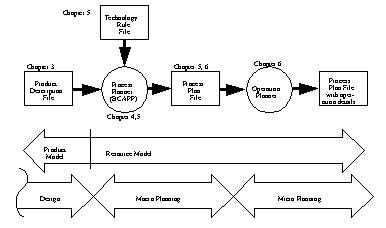1.5 STRATEGY OF THESISAn overview of the theory and software is presented here to help the reader keep the organization of the thesis in perspective. At present, BCAPP uses information from two different sources to find process plans. One input is the design definition. This definition is in the form of Boolean equations that act upon sets, as seen in the intuitive example. The approach to product modeling is described in detail in chapter 3. The second source of information is the manufacturing resources definitions. These are in the form of rules that describe available processes and requirements. Chapter 5 covers the details of modelling and selection of the resources. Both the design and rule files are used by the process planner. The planner is described over 3 chapters. The fundamentals of CAPP systems are covered in Chapter 2. In Chapter 4 the basics of Artificial Intelligence Planning systems are covered. Finally, in Chapter 5 the implementation for the BCAPP planning system is presented. The major contribution of the thesis is; the design representation in Chapter 3 and the rules and planner in Chapter 5. Chapter 6 describes a system that acts as a post processor for the high level planner. The material covered in Chapter 6 represents the role of other process planning systems that are designed for specific manufacturing technologies. Finally, Chapters 7, 8 and 9 present examples of the planners successes and failures, discuss the results, and suggest future work. The layout for the software is shown in Figure 1.5 The BCAPP Approach to Process Planning below. The product description file is at present provided by the user in the format described in Chapter 3. Eventually this could be provided by a commercial CAD package with minor modifications. The technology rule file is also provided by the user. This rule file must be developed so as to describe all resources in a factory. At present this file would have to be created by a trained Knowledge Engineer. Eventually the rule file could be entered through some inductive learning rule generation software. 
The process planning software (BCAPP) will accept the design file and the rule file, and attempt to find a process plan. The process plan steps will be added to the design file. At this point the process plan contains suggested operations and alternates, but it does not contain many details. (Please note that the contribution of this thesis is in the stages up to and including BCAPP, subsequent sections are provided for support only). After the high-level process plan is passed on, it is picked up by the operation planner (as described in chapter 6). This software will use existing CAPP systems to provide details necessary for production. In addition to this, the software must determine the operation sequences and deal with production failures. If, for some reason, a process plan cannot be executed then it is possible to restart BCAPP to provide more alternatives. |